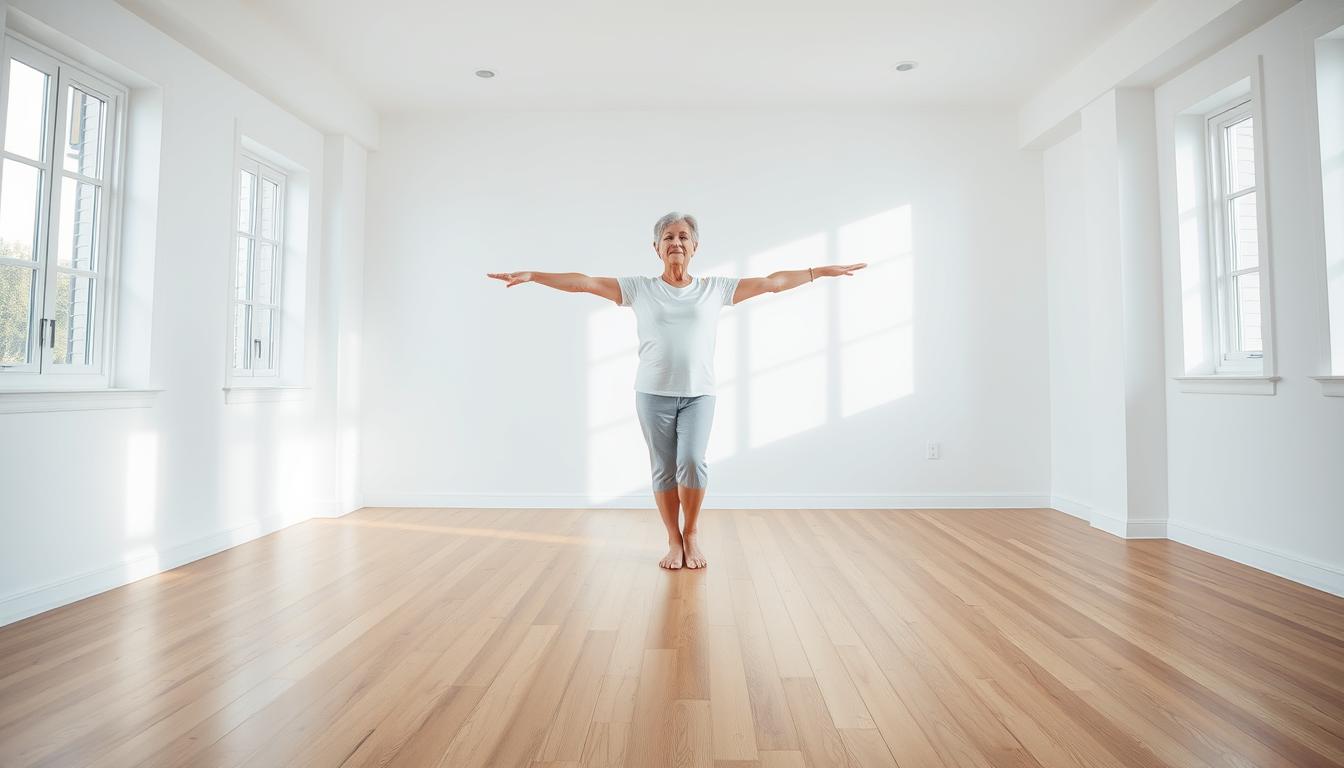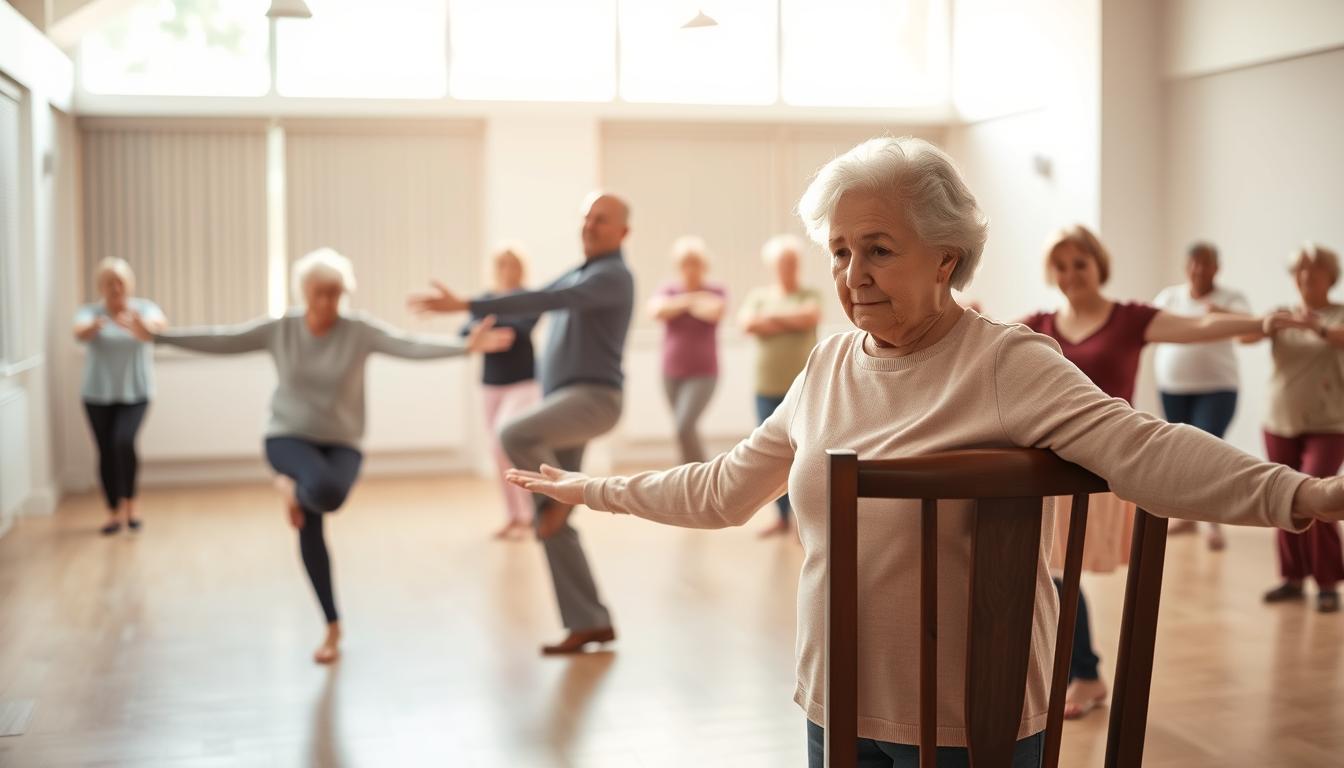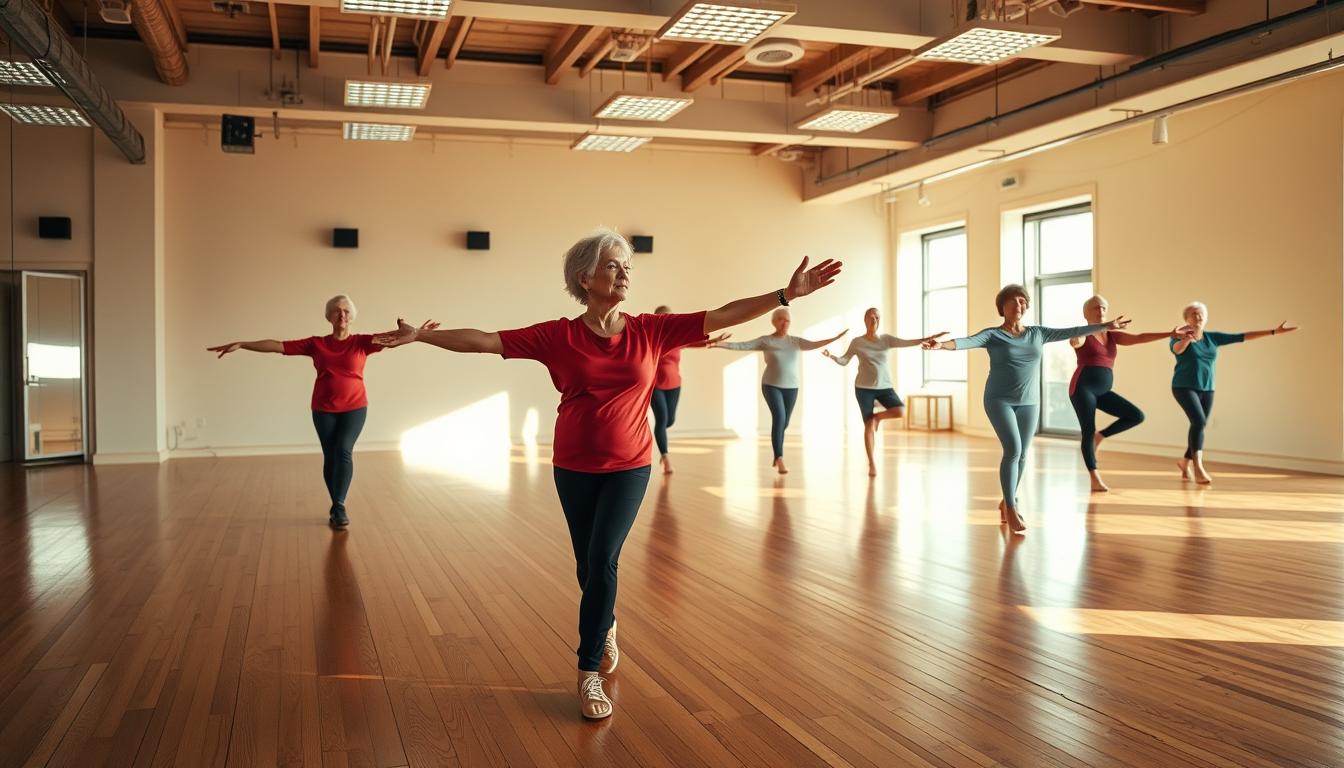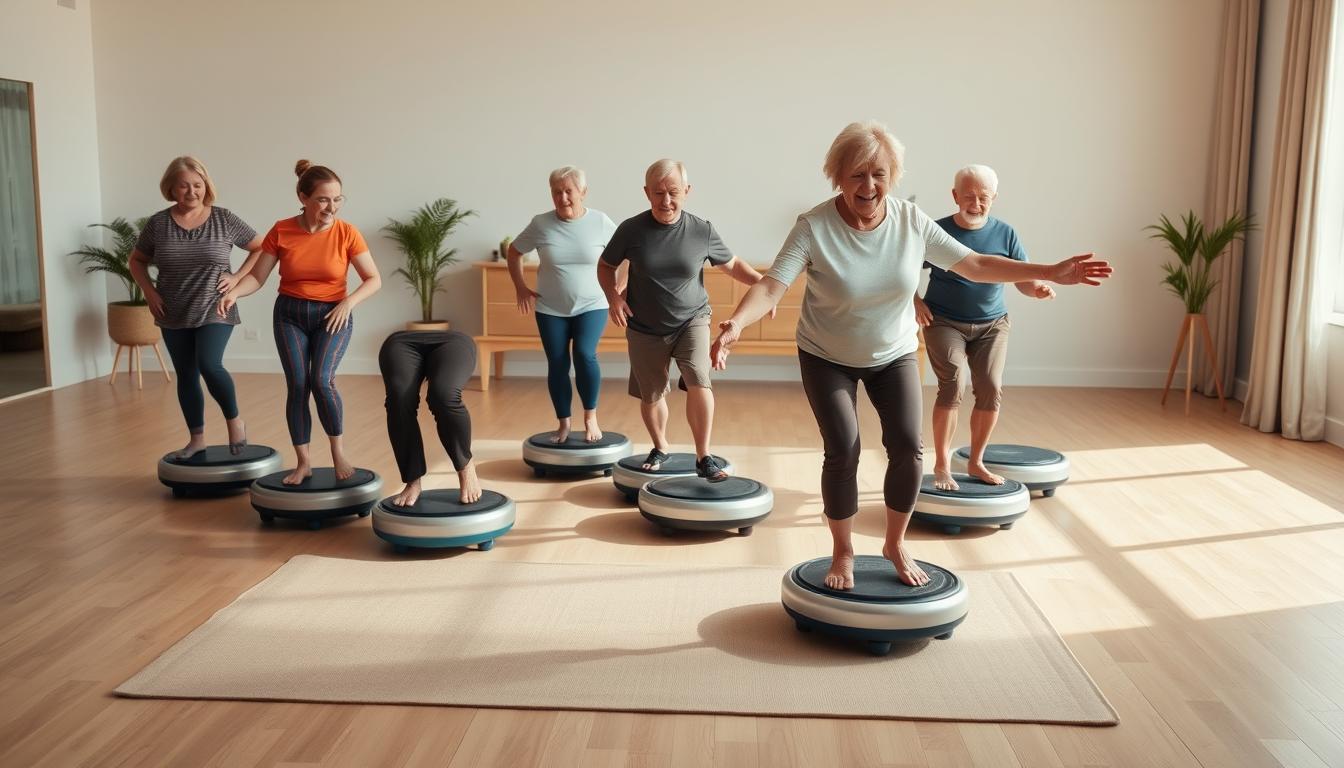Let’s cut to the chase: staying upright isn’t just about pride—it’s survival. Research shows simple movements done while vertical can slash fall risks by 23% in people over 65, according to the CDC. And since 1 in 4 older adults takes a tumble each year (often with life-altering consequences), this isn’t a “maybe later” conversation.
Here’s the kicker: your body’s stability system is like a three-legged stool. Muscle strength, inner-ear wizardry, and joint flexibility all need to play nice. But age loves to kick those legs out—subtly, like a sneaky raccoon stealing your trash cans. I’ve learned this firsthand after nearly face-planting while reaching for my coffee mug last Tuesday.
The good news? You don’t need fancy gear or a gym membership. Most moves require just a chair and two minutes of daily grit. Think of it as brushing your teeth… but for your equilibrium. And no, we’re not talking yoga pretzel poses—these are practical tweaks even my 82-year-old neighbor Barb (who still line dances) swears by.
Ready to turn shaky into steady? Let’s break down seven no-nonsense techniques that’ll keep you vertical, confident, and far from the ER’s slippery floors.
The Science Behind Age-Related Balance Decline
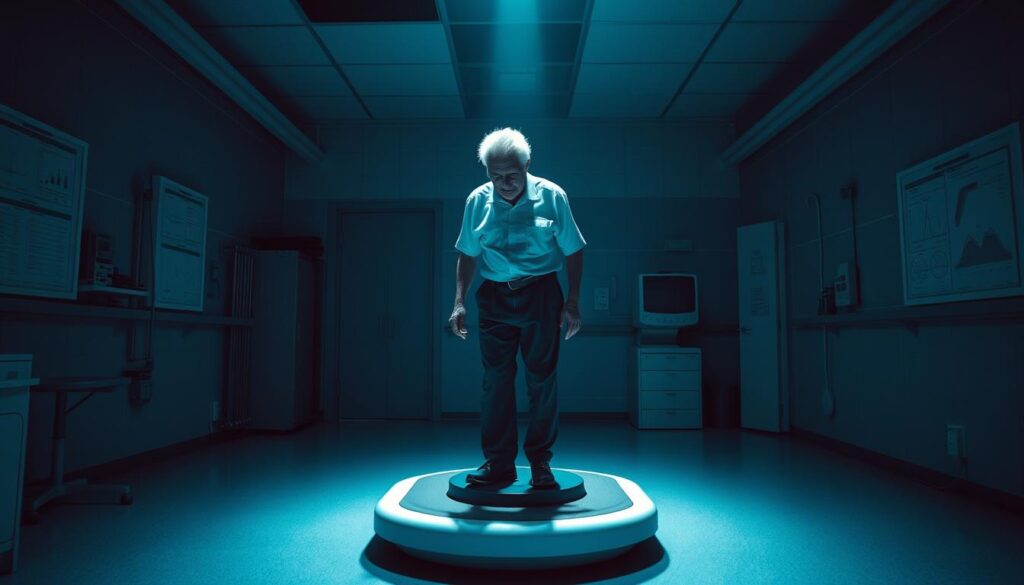
Ever wonder why staying steady gets trickier as we age? Your body’s stability relies on three silent partners: muscles that shrink like forgotten freezer leftovers, inner-ear sensors that dull like old car speakers, and joints that stiffen faster than dried glue. By 75, we’ve lost up to 50% of our vestibular system’s precision—that’s your internal GPS going offline mid-journey.
Understanding Muscle Loss and Vestibular Changes
After 30, muscle mass dips 3-8% per decade unless you fight back. Think of it as your legs slowly turning into overcooked noodles. But here’s the kicker: just 10 weeks without strength training can slash stability by 14%, per University of Michigan research. Meanwhile, those inner-ear hair cells? They’re vanishing like socks in a dryer—making quick head turns feel like riding a tilt-a-whirl.
How High Blood Pressure and Chronic Conditions Impact Stability
High BP isn’t just about heart risks. Johns Hopkins found it boosts fall odds by 40%—partly because it messes with blood flow to your balance centers. Even minor players count: arthritic knees reduce “weight shift speed” (fancy talk for how fast you can catch yourself). The fix? Start small. Holding a stance for 5 seconds daily builds what PTs call “position memory” in your feet. And yes, bending that creaky knee slightly? It’s not a compromise—it’s biomechanical genius.
Bottom line: Your stability isn’t doomed. It’s just waiting for smart nudges. Like training your toes to grip the floor like eagle talons. Or practicing shifts from heel to ball-of-foot while waiting for coffee. These micro-moves rebuild what time steals—no marathon sessions required.
Standing Balance Exercises for Seniors: Step-by-Step Techniques

Picture this: You’re at the kitchen counter waiting for toast to pop. That’s prime time to train your legs without rearranging your day. These two moves work like hidden balance ninjas—quietly building strength where it matters most.
Rock the Boat and Weight Shifts for Quads and Calves
Stand behind a sturdy chair, feet hip-width. Shift weight to your right foot and slowly lift the left heel. Hold 5 seconds—feel that calf tighten? Now roll onto your left toes. Alternate sides 5x. Pro tip: Imagine you’re rocking a canoe without tipping over. This dance strengthens quads while teaching your feet to communicate with your brain faster than a text message.
Tree Pose Variations with Support Options
Place your left foot against your right ankle (keep toes on the floor). Hands can hover over a countertop. When steady, try lifting the foot higher—but only as far as you can without wobbling. Switch sides after 10 seconds. My neighbor Barb calls this “the flamingo shuffle.”
| Support Level | Hand Position | Foot Height |
|---|---|---|
| Beginner | Both hands on chair | Ankle only |
| Intermediate | One finger on wall | Mid-calf |
| Advanced | Arms out like wings | Above knee |
Notice how your leg muscles fire differently each time? That’s your body rewriting its balance playbook. And here’s a secret: holding positions for just 3 extra seconds daily can boost coordination by 18% in six weeks, according to balance researchers.
Hands-On Techniques to Improve Stability and Prevent Falls

Want to outsmart gravity? Here’s the secret: your elbows know things. I learned this after catching myself mid-stumble by bracing one hand against the fridge. Turns out, strategic posture tweaks can turn wobbly moments into “nailed it” victories. Let’s get tactile.
Posture Adjustments Using Wall or Chair Support
Try this while waiting for microwaved soup: Stand with your back against a wall, heels two inches out. Feel your shoulder blades press flat? That’s your spine’s natural “I’ve got this” position. Now lift your chin like you’re sniffing fresh cookies—instant 12% stability boost, per PT studies. Pro tip: Keep one chair nearby for quick fingertip touches. Not death-gripping it—just grazing the surface like a butterfly landing.
Balancing Moves to Sharpen Coordination
My go-to: The “Traffic Cop” drill. Face a blank wall and alternate raising your hands to different heights. Left hand high, right hand low—hold for 3 breaths. Switch. It’s like patting your head while rubbing your belly, but for coordination. UCLA research shows this simple act improves weight-shift speed by 19% in eight weeks.
| Arm Position | Stability Benefit | Safety Level |
|---|---|---|
| Hands on hips | Engages core | Beginner |
| Arms out wide | Improves reaction time | Intermediate |
| Fingers interlaced overhead | Challenges balance | Advanced |
And here’s the kicker: Tilting your head slightly forward cuts fall risks by 8%. Why? It centers your inner ear’s fluid—like calming a snow globe. Next week, we’ll explore how to tweak these moves using laundry baskets (yes, really). Because staying upright shouldn’t feel like rocket science—just smart body hacking.
Modifying Moves to Match Personal Strength and Safety Levels
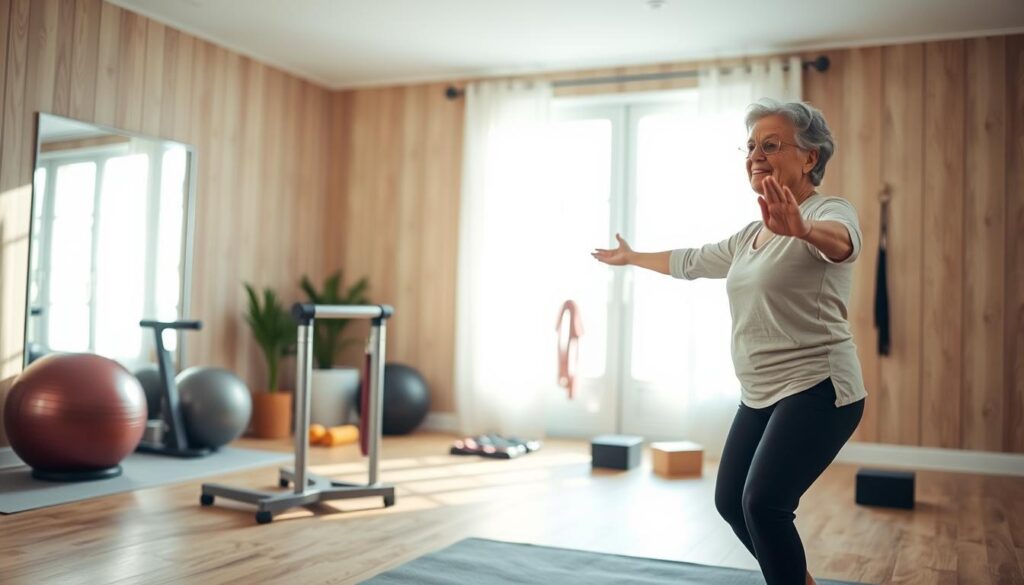
Think of stability work like your favorite soup recipe—sometimes you need less pepper, more broth. I learned this after watching my aunt modify her strength training by gripping her walker during leg lifts. Her secret? “If it feels shaky, change the recipe.”
Smart Support Tweaks for Real Life
That counter-height chair isn’t just for sitting. Try this: Place it at your side during single-leg stands. Rest two fingertips lightly on the backrest—enough to steady yourself without leaning. Feel your left leg working differently? That’s intentional. Research shows partial support builds 34% more muscle activation than death-gripping handles.
Here’s where creativity shines:
- Use a walker’s horizontal bar for seated marches (knees to chest)
- Shift weight to your stronger side first when practicing lifts
- Adjust hand positions every 3 days—palm flat vs. fingertips only
Last week, a client told me her “aha” moment: rotating her chair 45 degrees helped her see TV while doing heel raises. That slight turn took pressure off her weaker left leg—proof that smart angles beat brute strength.
Remember: Your training should adapt like your favorite jeans. A quarter-inch seam allowance here, a looser waistband there. Because staying upright isn’t about perfect form—it’s about crafting moves that stick.
Integrating Core Strength and Daily Balance Routines

What if your morning coffee routine could double as a balance workout? Turns out, everyday tasks are secret training sessions waiting to happen. Here’s how to hack your habits:
Your Chair Is a Gym in Disguise
Next time you stand up from sitting, try this: Shift your body slightly forward until your nose hovers over your toes. Press through your heels like you’re pushing the floor away. This simple tweak engages muscles most seniors rarely activate—no gym required.
Three stealthy moves to try today:
- Add two extra steps when pivoting to grab the remote
- Hold the “half-stand” position for three breaths before fully rising
- Alternate crossing your ankles under the table during meals
My client Martha (76) calls this her “spy training.” She improved her sit-to-stand speed by 22% in six weeks—just by modifying how she answers phone calls. Research shows these micro-sessions can boost hip strength by 19% when done three times daily.
| Seated Task | Muscle Group | Time Investment |
|---|---|---|
| Watching TV | Quadriceps | 5 sec per commercial |
| Reading | Core | 2 min per chapter |
| Phone calls | Glutes | 3 reps per conversation |
The magic happens in the margins. Those five extra seconds holding a stance while brushing teeth? That’s 30% more core engagement than sitting passively. And yes, leaning sideways to reach your water glass counts—your body doesn’t care if it’s “real” exercise or just living life.
Remember: Consistency beats intensity. Three intentional steps today build steadier tomorrows. Your kitchen counter’s waiting—time to make stability your side hustle.
Wrapping Up and Moving Forward With Confidence
Here’s the truth no one tells you about staying upright: every wobble conquered is a future bruise avoided. Those extra seconds spent shifting weight from heel to toes? They’re not just building calf muscles—they’re wiring your brain to react faster than a startled cat.
I’ve seen clients transform shaky steps into rock-solid strides by doing two things: using strategic support (hello, trusty kitchen counter), and treating daily tasks as stealth training. That slow lift of your left foot while waiting for the microwave? It’s a coordination drill in disguise.
Three non-negotiable takeaways:
1. Partial support beats no effort—graze that chair backrest like you’re testing stove heat
2. Five-second holds today prevent 30% faster muscle loss tomorrow
3. Mental sharpness spikes when your feet constantly negotiate new terrain
My client Ed (78) now balances on one leg while brushing his teeth—his “dental stance drill” boosted his hip strength enough to hike Machu Picchu. Your version might be simpler, but the principle holds: micro-wins create macro results.
So keep your head up—literally. That slight chin tilt centers your inner GPS. And remember: chairs aren’t crutches. They’re partners in your anti-gravity rebellion. Now go rewrite what “steady” means to your body.
